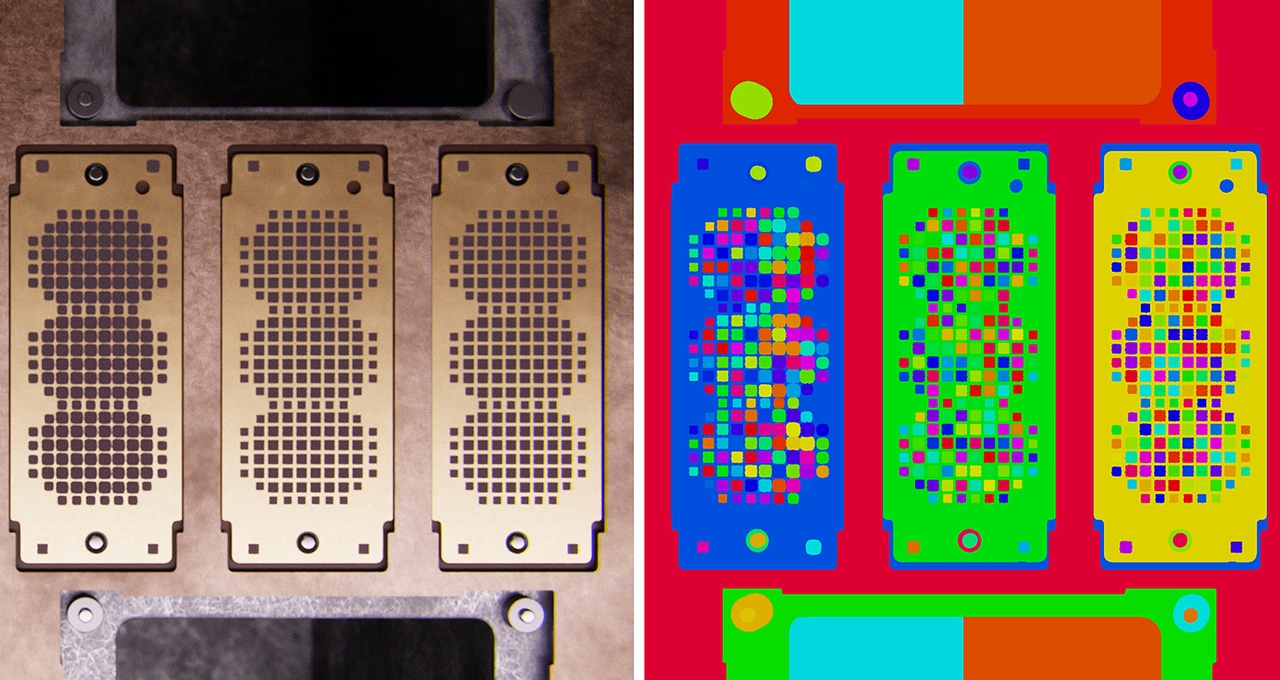Industrial leader Siemens is accelerating development of defect detection models with 3D synthetic data generation from NVIDIA Omniverse, the latest manufacturing gains to emerge from an extended partnership for the industrial metaverse that aims to advance digital twins.
The Siemens Xcelerator and NVIDIA Omniverse platforms are building connections to enable full-design-fidelity, live digital twins that connect software-defined AI systems from edge to cloud.
Europe’s largest industrial manufacturer manages a lot of moving parts, so AI-driven defect detection promises to boost quality assurance and yield at massive scale.
But building AI models requires hefty amounts of data, and producing labeled datasets for training models to detect defects is a time-consuming and expensive process. In most cases, such data may not cover all the types of defects or their locations.
Using NVIDIA Replicator and Siemens SynthAI technology, we can procedurally generate sets of photorealistic images using the digital models of our products and production resources and an integrated training pipeline to train ready-to-use models. This speeds up our set-up time for AI inspection models by a factor of five. — Maximilian Metzner, of GWE.
As a result, Siemens has begun tapping into NVIDIA Omniverse Replicator running on Amazon G5 instances for synthetic data generation, accelerating its AI model development times from taking “months” to “days,” according to the company.
Synthetic data is turbocharging model development. It’s boosting datasets for everything from German company Festo’s robotic arm work, to efforts at Amazon Robotics using synthetic data to train robots to identify packages.
At Siemens, synthetic data generation is being used beyond defect detection to assist in areas including, but not limited to, robotic bin picking, safety monitoring, welding and wiring inspections, and checking kits of parts.
“The better the synthetic data you have, the less real data you need — obtaining real data is a hassle, so you want to reduce that as much as possible without sacrificing accuracy,” said Alex Greenberg, director of advanced robotics simulation at Siemens Digital Industries Software.
Register for NVIDIA GTC, which takes place March 17-21, to hear how leading companies like Siemens are using the latest innovations in AI and graphics. And join us for OpenUSD Day to learn how to build generative AI-enabled 3D pipelines and tools using Universal Scene Description.
Inspecting Motion Control Devices
The Siemens Motion Control Business Unit produces inverters, drive controllers and motors for more than 30,000 customers worldwide. The lead electronics plant, GWE, based in Erlangen, Germany, has been working on AI-enabled computer vision for defect detection using custom methods and different modes of synthetic data generation.
Common synthetic data generation methods, however, weren’t sufficient for production-ready robustness in some use cases, leading to a need for real data acquisition and labeling, which could take months.
GWE worked with the Siemens’ Digital Industries Software division to find a better way to produce datasets.
“For many industrial use cases, products are changing rapidly. Materials are changing rapidly. It needs to be automated in a fast way and without a lot of know-how from the endpoint engineer,” said Zac Mann, advanced robotics simulation lead at Siemens Digital Industries Software.
Catching Printed Circuit Board Defects
The challenge at GWE is to catch defects early in the ramp-up of new products and production lines. Waiting for real errors to happen just to enhance the training datasets is not an option.
One area of focus for defects in a printed circuit board (PCB) is examining the thermal paste that’s applied to some components on the PCB in order to help transfer heat quickly to the attached heatsink, away from the components.
To catch PCB defects, the Siemens Digital Industries Software team took another approach by relying on synthetic data driven by Omniverse Replicator.
With Omniverse, a platform for building custom 3D pipelines and simulating virtual worlds, Siemens can generate scenarios and much more realistic images easily, aided with RTX technology-enabled physics-based rendering and materials.
This enables Siemens to move more quickly and smoothly at developing to close the gap from simulation to reality, said Mann.
“Using Omniverse Replicator and Siemens SynthAI technology, we can procedurally generate sets of photorealistic images using the digital models of our products and production resources and an integrated training pipeline to train ready-to-use models. This speeds up our set-up time for AI inspection models by a factor of five and increases their robustness massively,” said Maximilian Metzner, global lead for autonomous manufacturing systems for electronics at GWE.
Tapping Into Randomization With SynthAI
GWE engineers can now take a 3D CAD model of the PCB and import that into Siemens’ SynthAI tool. SynthAI is designed to build datasets for training AI models.
Tapping into Replicator, SynthAI can access its powerful randomization features to vary the sizes and locations of defects, change lighting, color, texture and more to develop a robust dataset.
Once data is generated with Replicator, it can be run through a defect detection model for initial training. This enables GWE engineers to quickly test and iterate on models, requiring only a small set of data to begin.
“This gives you visibility earlier into the design phase, and it can shorten time to market, which is very important,” said Greenberg.
Get started using NVIDIA Omniverse Replicator.
